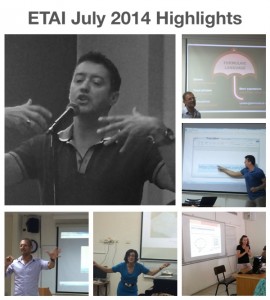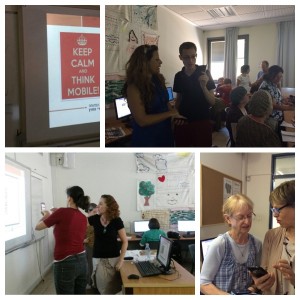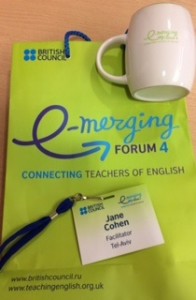Russell Stannard, creator of www.teachertrainingvideos.com, was this year’s British Council sponsored presenter. Russell started his hectic presenting schedule with a 90 minute workshop which focused on getting students speaking and developing their fluency through the use of digital tools. Russell started us off with a pair-work activity in the virtual classroom, set up by Russell, on TodaysMeet. We quickly joined the classroom and wrote our greetings to Russell before being asked to define the role of Learning Technologies in the classroom. We finished off with an activity for low level learners where we had to list all of the fruits we could think of. The fact that students don’t need to sign up to the site makes it immediately attractive for teachers. It is intuitive and easy to use and a cool tool for brainstorming. Russell went on to share with us a variety of tools that he has used over the years to encourage his students to speak both inside and outside of the classroom in a connected way: mailvu, vocaroo, Brainshark and presentMe. As always Russell’s energy had everybody excited about using this great audio visual tools. You can check out Russells presentation here.
‘M is for More and Making the Most’ was Russell Stannard’s talk on day one of the conference which focused on a variety of screen capture tools, and in particular JING. Russell described how these tools meet the needs of different learning styles. Russell shared examples of how he uses these tools to provide oral feedback to students on their presentations and written work. Russell has found the results to be very powerful as the combination of spoken feedback together with highlighted text, is more likely to be embedded by learners than traditional feedback methods. Russell has also used screen capture for teaching pronunciation. Russell gives a word list and then highlights the syllables to be emphasised, whilst adding his voice. A nice homework task is to get students to choose a picture of a famous person, JING it, and then record your voice describing the person. The JING lind can then be uploaded onto a class WIKI or blog or sent directly to the teacher. Russell demonstrated in Chinese (which he is currently learning) how even beginner students can provide oral information about themselves with screen capture. Russell typed on a word document: Tell me 3 things about yourself: Name; Job and the Languages you speak. Russell then JINGed it, recorded his speaking which he can then simly upload, or send it to his teacher. See Russell’s presentation here.
Russell Stannard gave the closing plenary ‘Where is Technology Taking Us? to a packed auditorium. Russell discussed how collaboration and communication are now the essential skills required by employers for new recruits in the 21st century workplace. Consequently teaching and learning needs to change to prepare learners to become lifelong learners, who will need to be autonomous. We need to prepare them to train, retrain and retrain again as new professions are constantly being created. This is particularly pertinent to language learning, as English is needed more and more as the global tool of communication. As teachers we need to think about how we can help our students become better learners, how we can encourage them to collaborate and work in teams and focus on problem solving on real world tasks. We need to look for ways to assist our students to make decisions about their own learning. Russell left us all with the desire for more. You can see Russell’s presentation here.
Leo Selivan, had his audience totally absorbed in his workshop ‘Not a word was spoken (but many were learned)’ Leo took his former film in the classroom workshops to a whole new level, with ‘Sound Off’ and ‘Vision Off’, ‘Split viewing’ and ‘Dictation’ techniques being radically upgraded through the use of silent movies and lots of pair/group work. Leo’s chose of short movies which provided language rich speaking opportunities, along with the given task of ‘commentating’ the movies, was both challenging and entertaining and pedagogically sound. Check out Leo’s handout here.
In ‘What Teen Learners Can Learn from Children’, Leo Selivan shared with us his passion for lexis. I loved the analogy of the ‘Biological Clock of the brain’, whereby our ability to learn languages decreases dramatically as we get older. This certainly rings true for me. Leo described Krashen’s model, whereby language can be acquired either implicitly or explicitly, where acquisition is defined as a subconscious process, similar to L1 learning, whereas in contrast learning is a conscious process and the result of formal instruction. Leo pointed out that child learners see language as a tool for communication in contrast to older learners who are aware of language as a phenomenon. Leo shared language research by Fillimore and Wray to demonstrate what older learners can learn from children. Leo concluded by telling us to start teaching with chunks and then try and accelerate the process of chunk learning, we should focus on probable language rather than possible language. You can see Leo’s presentation here.
Dr Carol Goldfus gave a riveting presentation, ‘The Brain and Music’ in which she described how teachers can use music to shape the brain and dramatically improve learning outcomes – “Teachers are’ after all the ultimate brain changers “they are in a profession of changing the human brain every day,” Sousa, 2010, p.23. Goldfus’ energetic statement, ‘We teach language, we do not teach the present simple because the present is not simple. We do not teach the present perfect because the present is far from perfect. We teach language,’ clarified even more forcefully for me why grammar should take the back seat in our classrooms. Goldfus explained that humans are not born with a reading a brain, but rather it is developed through good teaching. Goldfus suggested playing music at the beginning and end of a lesson and teaching in the middle. The reasoning for this is that by listening to music the frontal part of the brain is activated, it is this part of the brain that that is responsible for planning and spoken language. Goldfus asserted that by listening to music we are naturally rewiring the brain. Classical music can be used as an intervention tool for teaching. It provides an excellent model for organizational and rule-governed behaviour. Goldfus asserted that the goals of listening to music in the language classroom are:
1. To develop sensitivity to organizational and rule-governed language
2. To develop timing, sequentiality and fluency
3. To develop word meaning and store the information in the brain
The audience left the room with a strong awareness of the power of music and our power as humans to rewire our own brains, and to assist our students to do so too.
For details of my own PCE Think mobile! Think more! workshop you can read my post here.


